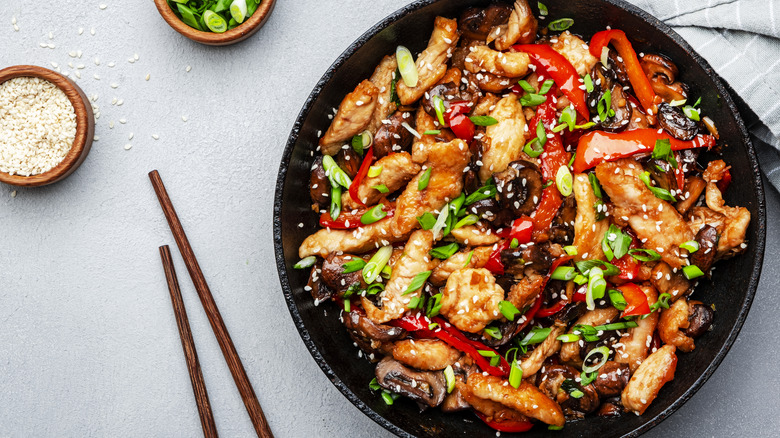Avoid Cutting Your Chicken Too Small When Making Stir-Fry
Stir-fry is a go-to meal for many home cooks, and for good reason. Whether you're whipping up a quick weeknight meal or savoring a long evening of cooking, it's hard to beat a delicious mix of meats and vegetables seasoned in flavorful oils and sauces. From sweet pork and pineapple to classic beef and broccoli, these nutrient-dense dishes combine a variety of food groups and can accommodate a nearly limitless number of fresh ingredients.
Central to a great stir-fry is a good protein source. Chicken is an excellent choice because its mild flavor pairs well with a variety of ingredients. Like other proteins, chicken becomes coated in the tasty sauce. Plus, its firm texture complements the crunch of your favorite veggies. Stir-fry can be challenging to get just right, but you can give yourself a big advantage by preparing ingredients — especially chicken — correctly. To elevate your next stir-fry and keep from overcooking the meat, don't cut chicken pieces that are too small.
The right way to prepare stir-fry chicken
Small cuts of chicken are incredibly easy to overcook in a hot pan. Stir-fry dishes are usually prepared over very high heat, and once diced chicken hits the sizzling surface of a wok, it starts cooking rapidly. The smaller the pieces of chicken, the quicker they'll cook, and the less margin for error you'll have before they turn chewy and tough.
Cutting chicken too small can also lead to inconsistent cooking between pieces. Perhaps the only thing worse than a plate of overdone chicken is a dish where some pieces are tough and others are still a bit raw. The key to consistency is cutting all the pieces the same size. But, that can be challenging when making very small cuts. In an interview with Epicurious, chef Chris Morocco notes that while uniformity is the goal, realistically "your cubes will never be exactly ½-inch on all sides." When you cut chicken into small pieces you risk losing uniformity, which can lead to inconsistent doneness.
The best way to cut chicken? Try slicing. Morocco recommends using ½ inch slices of chicken instead of cubes to increase the size and avoid the pitfalls of small cuts. With only two prominent sides, chicken slices are easier to turn and control in a pan compared to cubes, which can often roll around like balls. Slices are large enough, Morocco notes, that you can actually brown the meat and then simmer it in the sauce without fear of overcooking.
More hacks for tender stir-fry chicken
Size may be an important factor when preparing chicken, but it's far from the only tip to be aware of when cooking a stir fry. Besides cutting larger pieces, make sure to cut strips of chicken against the grain. The "grain" refers to the strips of muscle fibers found running along the piece of meat. Cutting meat against the grain increases the tenderness of the cooked piece of chicken and makes it much easier to chew.
Still having trouble with tenderness? You should also consider what kind of chicken meat you're purchasing. Typically, younger chickens have more tender meat while older birds will be tougher. If you're purchasing whole chickens at the grocery store, look for broiler-fryer birds or capons. According to the USDA, these smaller chickens produce tender meat under a variety of cooking methods while some of the older chickens require moist cooking techniques over longer periods of time.
Different preparation techniques can also help maximize the quality and flavor of your chicken. Your kitchen is likely already filled with liquids for brining chicken, from milk to apple juice. Soaking chicken in a simple brine helps the meat maintain moisture throughout the cooking process. If you'd prefer to focus on enhancing the flavor, try adding the meat to a marinade. Use your favorite herbs and spices for inspiration, or experiment with some unusual marinade ingredients. Either method will help tenderize chicken and take your stir-fry to the next level.


